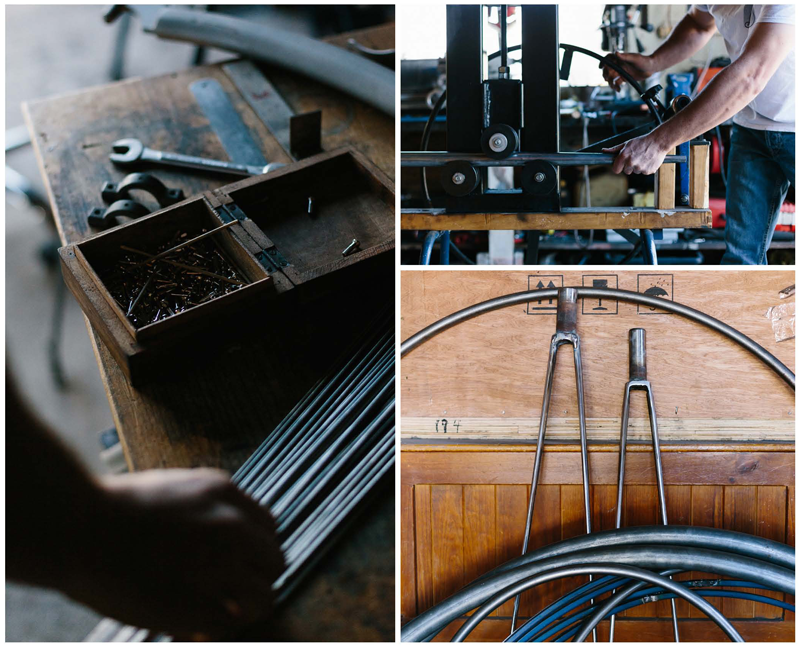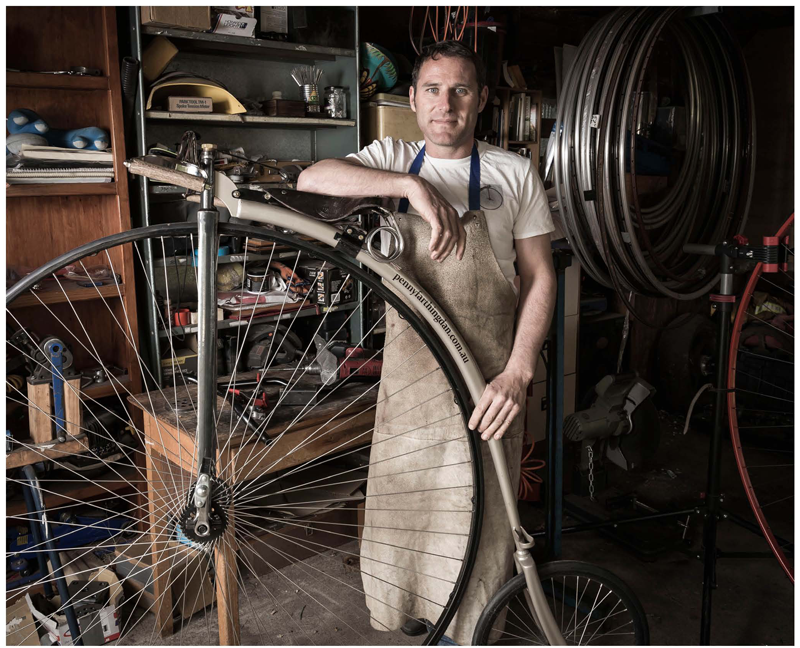Melbourne is a cycling city; there’s a vibrant MTB culture, roadies cruise the hinterland willy-nilly, and the urban centre plays host to town bikes, cargo bikes and hipsters on fixies. Less well known is the fact that just north of the city is a builder of the original fixie – Dan Bolwell, who creates penny farthings.
Penny farthings are regarded as the first real bicycle; before they appeared the hobbyhorses and velocipedes of the time were not really a viable transport solution. Penny farthings boomed from the late 1860s until the 1880s, when the advent of the safety bicycle saw their demise. Apparently the cycling population took to the idea of brakes, gears and the ability to reach the ground from the saddle. Despite their star only rising for 20 years or so, they remain, for many, an iconic symbol of vintage cycling.
As a young lad, Dan Bolwell had an encyclopedia (which is a kind of analogue Google, for those unfamiliar with such a thing). Under “History of Cycling” was a picture of a penny, and this sparked his imagination. Fast-forward to 12 years ago, and we find Dan in the shed armed with a hammer, creating his own version of that bike that was still lurking in the back of his head. Fast-forward again to now, and he builds them for a living.
Dan is Australia’s only full time penny builder, and quite possibly the only bespoke penny builder in the world. This means essentially that every bike is custom built for the client – there are no racks of stock such as might be found in a bike shop. Every bike begins with extensive consultation, and Dan’s knowledge and experience help guide a customer who might not be quite sure what they want to select a style that will best suit them.
To the inexperienced a road bike is two wheels and a diamond frame with some curvy handlebars. To road riders, however, the nuances are endless – touring, race, endurance, cyclocross, gravel grinder, time trial, aero, so on and stop me there, please. Penny farthings are no different, having subtleties that will enhance the bike’s intended use, and this is what is sorted out in the planning phase.
Most importantly, the seats on these bikes are not adjustable, so the radius of the wheel combined with the crank length must suit the rider’s inseam length. Riders keen on speed might select a short crank and big wheel to spin fast and go far, while more touring-oriented riders may opt for a longer crank and smaller wheel to better hill climb, and ease the long days in the saddle. It’s all about the balance between torque and horsepower. Wheels generally range from 48 inches diameter right up to 58 inches if you are long of leg. Just bought a 29er because you like big wheels? Think again …
Customers also need to choose rim materials (steel or aluminium), colour, handlebar style, grips, seat and whether any parts are to be plated in nickel, copper or gold. Essentially, you get a backbone and then choose everything else, whether you want an electric orange alloy rim race bike or a heritage inspired nickel-plated showpiece.
 Once the decision-making is complete, Dan assigns you the next available build slot. His year is divided into two week blocks, which are designed to give him time to build the bike, as well as attend to all those other small matters of business – ordering, banking, maintenance, having a life and so on. In this way the ongoing business is sustainable, and orders do not overwhelm supply, allowing him to deliver to the customer in the time frame forecast. Simple maths therefore suggests his output is around 25 bikes a year. The waiting list? Six to nine months.
Once the decision-making is complete, Dan assigns you the next available build slot. His year is divided into two week blocks, which are designed to give him time to build the bike, as well as attend to all those other small matters of business – ordering, banking, maintenance, having a life and so on. In this way the ongoing business is sustainable, and orders do not overwhelm supply, allowing him to deliver to the customer in the time frame forecast. Simple maths therefore suggests his output is around 25 bikes a year. The waiting list? Six to nine months.
So to the price for all this. Most basic bikes begin around $3,500 before GST, and prices then increase based on the customer’s desire for metal plating, funky spoke patterns or crazy one-off bars. Given what some people pay for custom bikes, or even high-end off-the-shelf bikes, it seems like a bargain.
The resulting bikes could probably be best described as vintage inspired, because they blend old and new. While they are a high wheel bike with a traditional style headset, Dan is not shy of using high tensile steel, alloy rims or powder coating to make his bikes stronger and more enjoyable to ride, even if these things were not available to original builders. The bikes are handmade in a shed, where old techniques and hand made tools sit next to state-of-the-art welders. There is not one piece of straight metal on the bikes, so it is still all about old-world, hands-on skill and crafting.
These are not so much true replicas as interpretations, although it would take a practiced eye to tell the difference. The bikes amaze most people, without them being concerned about the steel in the forks. They are made to be ridden, and even if you just want a showpiece to hang on the wall or advertise a business, you will still get the same quality of product. Partly this is professional integrity, but also because Dan has found over the years that even people thinking they want a decorative piece end up riding the bike more than anticipated. He estimates that the average use his bikes each received last year was between 2,000 and 4,000 kilometres, and his own steed has done over 12,000 kilometres since being built. The maintenance bill for all those miles? Roughly zero. Original bearings, original tyres, and there’s nothing else to wear out. The virtues of simplicity are manifest with these machines.
Dan’s bikes have been exported to Malaysia, Thailand, Singapore, UK, US and Norway as well as gracing our own shores, and have been used in stage productions and advertising campaigns. There is no “typical” buyer, as every customer seems to have their own unique reason for wanting one of these machines, and this has led to a vibrant community of aficionados. There are international events, plus three national events every year, including the National Penny Farthing Championships in Evandale, Tasmania, which is the largest annual gathering of pennies worldwide. In addition there are various state groups and clubs, and here in Victoria there are rides roughly once a month run by an informal crew who, once dressed in a motley array of vintage, steampunk and tweed clothing and perched astride high wheel bicycles, must be one of the least threatening gangs to roam our streets. At the other end of the spectrum is the Annual Penny Farthing tour, which sees riders travelling up to 1,000km in 8 days, reminding us all that there is no reason not to travel real distance on these anachronisms. After all, the first circumnavigation of the world by bike was by penny.
In Dan’s own words, “in a world of disposable items, cheap manufacturing and products designed for a price rather than quality, I offer a fresh alternative.” Like the original penny farthings, some now 130 years old and still being ridden, Dan’s bikes are functioning works of art, designed to last and each one unique to its rider.

